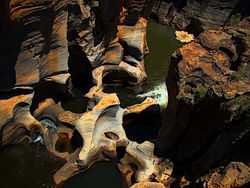Giant's kettle

A Giant's kettle, also known as giant's cauldron or pothole, is a cavity or hole which appears to have been drilled in the surrounding rocks by eddying currents of water bearing stones, gravel and other detrital matter.
The interiors of potholes tend to be smooth and regular, unlike a plunge pool. An example is the large pothole found in Archbald, Pennsylvania in Archbald Pothole State Park.
Formation

Potholes vary in size from a few inches to several feet in depth and diameter. They most commonly occur in shields, where there are ancient rocks (granite, gneiss) with different resistances to erosion, so strong pebbles can fall into small cavities in stream bottoms and swirl, making the cavities wider and deeper. The hardness of the pebbles must be the same or higher than the rock at the bottom of stream where the kettle is forming. In areas where there are diamonds and quartz pebbles, the hardness of these carve potholes and sometimes remain trapped in the bottom of them.[1] That is why these potholes are a good place to find diamonds (the hardest natural mineral on Earth).[citation needed]
Giant's kettles can also be formed while the surface is covered by a glacier. Water, produced by the thawing of the ice and snow, forms streams on the surface of the glacier, which, having gathered into their courses a certain amount of morainic debris, finally flow down a crevasse as a swirling cascade or moulin. The sides of the crevasse are abraded, and a vertical shaft is formed in the ice.[2] The erosion may be continued into the bed of the glacier; and, the ice having left the district, the giants kettle so formed is seen as an empty shaft, or as a pipe filled with gravel, sand or boulders. Such cavities and pipes afford valuable evidence as to the former extent of glaciers.
Similar holes are encountered in riverbeds at the foot of cascades, and under some other circumstances.
Notable kettles
The GletscherGarten of Lucerne (Switzerland) is famous for its giant's kettles, having 32 in number, the largest being 8 m (26 ft) wide and 9 m (30 ft) deep. They are also common in Germany, Norway (jettegryte), Sweden (jättegryta), Finland (hiidenkirnu; hiisi's churn) and Moss Island in the United States.
In the northern Great Plains of North America, wetlands formed in glacial kettles are known as prairie potholes.[3]
See also
References
- ↑ Nick Norman, Gavin Whitfield (2006). Geological journeys: a traveler's guide to South Africa's rocks and landforms. Struik Publishers. p. 287. ISBN 1-77007-062-1.
- ↑ BULLETIN OF THE MASSACHUSETTS ARCHAEOLOGICAL SOCIETY XIV (4): 112. July 1953 http://library.bridgew.edu/exhibits/BMAS/pdf/MAS-v14n04.pdf
|url=missing title (help). Retrieved 12 July 2010. - ↑ Prairie Potholes, U.S. Fish and Wildlife Service Mountain-Prairie Region website. Accessed 8 April 2009.
External links
| Wikimedia Commons has media related to Giants kettles. |
![]() This article incorporates text from a publication now in the public domain: Chisholm, Hugh, ed. (1911). "Giant's Kettle". Encyclopædia Britannica (11th ed.). Cambridge University Press
This article incorporates text from a publication now in the public domain: Chisholm, Hugh, ed. (1911). "Giant's Kettle". Encyclopædia Britannica (11th ed.). Cambridge University Press
